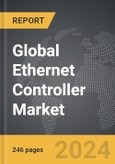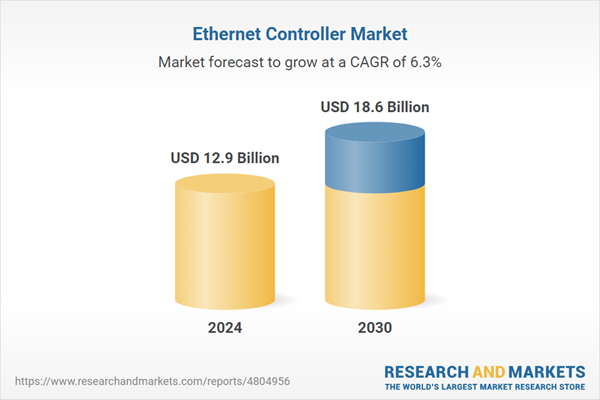Global Ethernet Controller Market - Exploring Trends & Growth Catalysts
Why Are Ethernet Controllers at the Core of Modern Networking?
Ethernet controllers have become the backbone of modern networking, playing a crucial role in facilitating high-speed, reliable, and secure data transmission across various industries. These controllers are integrated circuits or network interface components that manage data flow between a device's central processing unit (CPU) and the network. Whether in enterprise data centers, industrial automation, automotive systems, or home networking, Ethernet controllers ensure seamless connectivity and efficient communication, enabling the rapid exchange of large volumes of data.The growing demand for high-speed internet, cloud computing, and data-intensive applications has fueled the adoption of Ethernet controllers. Enterprises rely on these components to manage server connectivity, optimize data transfer, and support high-bandwidth applications such as artificial intelligence (AI), machine learning, and video streaming. In industrial settings, Ethernet controllers are increasingly being used in automation and robotics, ensuring low-latency and high-efficiency machine-to-machine communication. Additionally, the rise of Internet of Things (IoT) devices has further strengthened the demand for advanced Ethernet controllers, as smart homes, connected vehicles, and industrial IoT (IIoT) systems require robust and scalable networking solutions.
How Are Innovations and Technology Advancements Enhancing Ethernet Controllers?
Technological advancements have significantly improved Ethernet controllers, enhancing their speed, efficiency, and security. One of the most notable developments is the transition from traditional 1-Gigabit Ethernet (1GbE) to higher-speed variants, including 10GbE, 25GbE, 40GbE, and even 100GbE controllers. These next-generation Ethernet controllers are essential for data centers and enterprise networks, where high-speed, low-latency connectivity is critical for cloud computing, AI-driven workloads, and big data analytics. Additionally, the rise of edge computing has accelerated the demand for high-performance Ethernet controllers that can efficiently process data closer to the source, reducing network congestion and improving real-time processing.Another key innovation is the integration of enhanced security features within Ethernet controllers to combat cyber threats and data breaches. Advanced encryption algorithms, secure boot functionality, and hardware-based authentication mechanisms have been incorporated into modern controllers to protect against unauthorized access and malicious attacks. Moreover, the development of energy-efficient Ethernet (EEE) standards has led to controllers that consume less power while maintaining optimal performance, addressing the growing need for sustainable and energy-efficient networking solutions. As artificial intelligence and software-defined networking (SDN) continue to evolve, Ethernet controllers are also being optimized with intelligent traffic management capabilities, improving network efficiency and adaptability in dynamic environments.
Which Industries Are Driving the Demand for Ethernet Controllers?
The Ethernet controller market has seen robust demand across multiple industries, with data centers and cloud computing leading the charge. As businesses transition to digital-first operations, data centers require high-speed Ethernet controllers to handle massive amounts of data, optimize server connectivity, and ensure uninterrupted cloud services. Major cloud service providers such as Amazon Web Services (AWS), Microsoft Azure, and Google Cloud are continually investing in high-bandwidth networking infrastructure, driving demand for advanced Ethernet controllers capable of supporting ultra-fast data transfer.The industrial automation sector is another key growth driver, leveraging Ethernet controllers for real-time communication in smart factories, robotics, and IIoT applications. With the rise of Industry 4.0, manufacturers are integrating Ethernet-based networking solutions into production lines, enabling seamless coordination between machines, sensors, and control systems. Meanwhile, the automotive industry has increasingly adopted Ethernet controllers for in-vehicle networking, supporting applications such as advanced driver-assistance systems (ADAS), autonomous driving, and infotainment systems. The expansion of connected vehicles and smart transportation solutions is expected to further accelerate Ethernet controller adoption in the automotive sector. Additionally, the telecommunications industry continues to rely on Ethernet controllers for high-speed broadband services, 5G infrastructure, and network backbone enhancements, further driving market growth.
What's Fueling the Rapid Growth of the Ethernet Controller Market?
The growth in the global Ethernet controller market is driven by several factors, including the increasing demand for high-speed, low-latency networking solutions in data centers, industrial automation, and telecommunications. The surge in cloud computing and big data analytics has significantly propelled the adoption of Ethernet controllers, as enterprises require scalable and high-bandwidth connectivity to support digital transformation initiatives. Additionally, the growing prevalence of IoT devices and edge computing has created a need for more efficient and intelligent networking solutions, further boosting the demand for Ethernet controllers.The expansion of 5G networks and next-generation telecommunications infrastructure has also played a crucial role in market growth, as Ethernet controllers enable high-speed data transmission across base stations and network equipment. Furthermore, the rise of cybersecurity threats has increased the demand for secure networking solutions, prompting manufacturers to develop Ethernet controllers with built-in security protocols and encryption capabilities. Government initiatives promoting smart cities and digital connectivity have further driven investments in advanced networking technologies, enhancing market expansion. With ongoing advancements in networking speeds, AI-driven optimization, and energy-efficient Ethernet solutions, the global Ethernet controller market is poised for sustained growth, shaping the future of high-performance digital connectivity.
Report Scope
The report analyzes the Ethernet Controller market, presented in terms of market value (USD). The analysis covers the key segments and geographic regions outlined below.- Segments: Bandwidth Type (Gigabit Ethernet); Packaging (Fast Ethernet, Switch Ethernet); Application (Servers, Consumer Applications, Routers & Switches, Other Applications).
- Geographic Regions/Countries: World; United States; Canada; Japan; China; Europe (France; Germany; Italy; United Kingdom; Spain; Russia; and Rest of Europe); Asia-Pacific (Australia; India; South Korea; and Rest of Asia-Pacific); Latin America (Argentina; Brazil; Mexico; and Rest of Latin America); Middle East (Iran; Israel; Saudi Arabia; United Arab Emirates; and Rest of Middle East); and Africa.
Key Insights:
- Market Growth: Understand the significant growth trajectory of the Gigabit Ethernet Bandwidth segment, which is expected to reach US$9.6 Billion by 2030 with a CAGR of 7.1%. The Fast Ethernet Bandwidth segment is also set to grow at 6.2% CAGR over the analysis period.
- Regional Analysis: Gain insights into the U.S. market, valued at $3.4 Billion in 2024, and China, forecasted to grow at an impressive 9.6% CAGR to reach $4.4 Billion by 2030. Discover growth trends in other key regions, including Japan, Canada, Germany, and the Asia-Pacific.
Why You Should Buy This Report:
- Detailed Market Analysis: Access a thorough analysis of the Global Ethernet Controller Market, covering all major geographic regions and market segments.
- Competitive Insights: Get an overview of the competitive landscape, including the market presence of major players across different geographies.
- Future Trends and Drivers: Understand the key trends and drivers shaping the future of the Global Ethernet Controller Market.
- Actionable Insights: Benefit from actionable insights that can help you identify new revenue opportunities and make strategic business decisions.
Key Questions Answered:
- How is the Global Ethernet Controller Market expected to evolve by 2030?
- What are the main drivers and restraints affecting the market?
- Which market segments will grow the most over the forecast period?
- How will market shares for different regions and segments change by 2030?
- Who are the leading players in the market, and what are their prospects?
Report Features:
- Comprehensive Market Data: Independent analysis of annual sales and market forecasts in US$ Million from 2024 to 2030.
- In-Depth Regional Analysis: Detailed insights into key markets, including the U.S., China, Japan, Canada, Europe, Asia-Pacific, Latin America, Middle East, and Africa.
- Company Profiles: Coverage of players such as Airespring, Inc., Amso Solar Technology Co., Ltd., Brainchild Electronic Co., Ltd., Broadcom, Inc., Burkert Contromatic Pvt., Ltd. and more.
- Complimentary Updates: Receive free report updates for one year to keep you informed of the latest market developments.
Some of the 46 companies featured in this Ethernet Controller market report include:
- Airespring, Inc.
- Amso Solar Technology Co., Ltd.
- Brainchild Electronic Co., Ltd.
- Broadcom, Inc.
- Burkert Contromatic Pvt., Ltd.
- Caucasus Online LLC
- Cisco Systems (India) Pvt., Ltd.
- Esconet Technologies
- Guangdong Ruirong Pump Industry Co., Ltd.
- ICP DAS USA, Inc.
This edition integrates the latest global trade and economic shifts into comprehensive market analysis. Key updates include:
- Tariff and Trade Impact: Insights into global tariff negotiations across 180+ countries, with analysis of supply chain turbulence, sourcing disruptions, and geographic realignment. Special focus on 2025 as a pivotal year for trade tensions, including updated perspectives on the Trump-era tariffs.
- Adjusted Forecasts and Analytics: Revised global and regional market forecasts through 2030, incorporating tariff effects, economic uncertainty, and structural changes in globalization. Includes historical analysis from 2015 to 2023.
- Strategic Market Dynamics: Evaluation of revised market prospects, regional outlooks, and key economic indicators such as population and urbanization trends.
- Innovation & Technology Trends: Latest developments in product and process innovation, emerging technologies, and key industry drivers shaping the competitive landscape.
- Competitive Intelligence: Updated global market share estimates for 2025, competitive positioning of major players (Strong/Active/Niche/Trivial), and refined focus on leading global brands and core players.
- Expert Insight & Commentary: Strategic analysis from economists, trade experts, and domain specialists to contextualize market shifts and identify emerging opportunities.
Table of Contents
Companies Mentioned (Partial List)
A selection of companies mentioned in this report includes, but is not limited to:
- Airespring, Inc.
- Amso Solar Technology Co., Ltd.
- Brainchild Electronic Co., Ltd.
- Broadcom, Inc.
- Burkert Contromatic Pvt., Ltd.
- Caucasus Online LLC
- Cisco Systems (India) Pvt., Ltd.
- Esconet Technologies
- Guangdong Ruirong Pump Industry Co., Ltd.
- ICP DAS USA, Inc.
Table Information
| Report Attribute | Details |
|---|---|
| No. of Pages | 246 |
| Published | January 2026 |
| Forecast Period | 2024 - 2030 |
| Estimated Market Value ( USD | $ 12.9 Billion |
| Forecasted Market Value ( USD | $ 18.6 Billion |
| Compound Annual Growth Rate | 6.3% |
| Regions Covered | Global |









